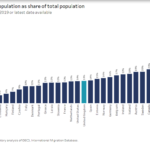Higher economic growth does not necessarily lead to better well being of a country’s citizens. Among the G-7 member countries the US has the highest GDP per capita but the lowest life expectancy according to an article by Prof.John Ross, Senior Fellow at Chongyang Institute for Financial Studies, Renmin University of China. The fact that Americans die younger despite high GDP growth per capita proves that factors such as social and environmental are important.
From the article:
The G7 Figure 4 therefore show life expectancy in the major advanced countries – the G7. This shows an average American has a life expectancy of only 78.7 years – compared to 83.8 years in Japan, 83.5 years in Italy, 82.7 years in France, 82.1 years in Canada, 81.6 years in the UK, and 81.1 years in Germany. The US is the only G7 country with a life expectancy of less than 80.Figure 4Detailed examination shows the relative situation of the US is even more serious. As the US has the highest per capita GDP of any major country it would therefore be expected that its life expectancy would be the highest of any major country. But the facts show that that the US has a much lower life expectancy than any other G7 economy – average life expectancy in the US is four years less than would be expected from its per capita GDP. The US also ranks 8th in the world in terms of per capita GDP but only 40th in terms of life expectancy – that is the US rank in life expectancy is 32 places lower than its position in per capita GDP. This US data is by far the worst for any G7 country.The G7 countries which have a higher life expectancy than the US all achieve this not by having a higher per capita GDP than the US but by having better social and environmental conditions – shown by their having a rank in life expectancy that is far higher than their rank in per capita GDP. Therefore social, environmental etc. conditions in these countries are far more conducive to a long life than the US despite having lower per capita GDPs. The US performs far worse than any other G7 country.Table 2
Differences in social model The fact Americans die earlier than those in the other major advanced economy shows that component parts of the American system – a US health care system which is private, US pollution, US poverty and interlinked ethnic discrimination, the US’s high level of civic violence, and other features mean Americans die far younger than would be expected from the country’s per capita GDP – and younger than in other comparable economies. It turns out the ‘American way’ literally subtracts from the life of Americans. No system which condemns its citizens to an early death could be called ‘the greatest’ as US politicians claim.In contrast, as already noted, of the world’s 10 countries with the highest life expectancy all have high per capita GDP with seven being in Europe (Italy, Spain, Switzerland, Iceland, France, Sweden and Australia) and three in Asia (Hong Kong SAR, Japan and Singapore). For studying the combination of per capita GDP and non-economic factors these countries are therefore the key ones from which to draw positive lessons. It is therefore clear that if the goal is not highest per capita GDP, but the maximising of social well-being, then the lessons of the US model are negative while the lessons of Europe and some high income Asian countries are positive.





